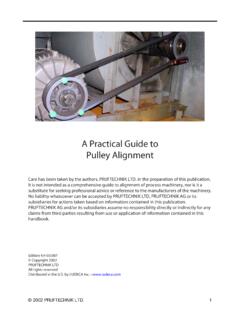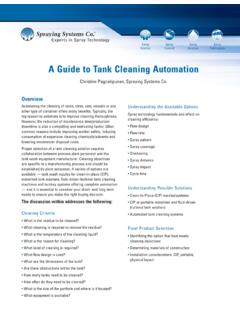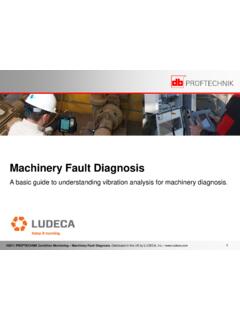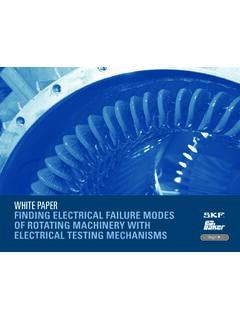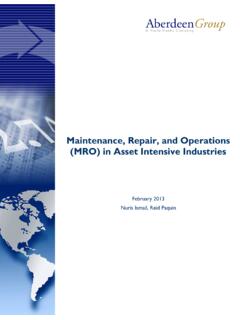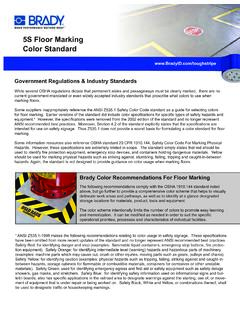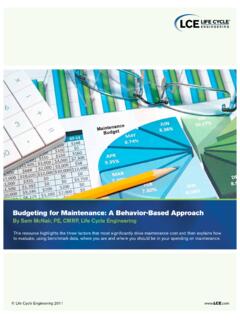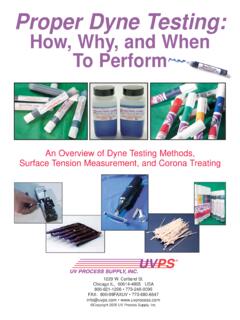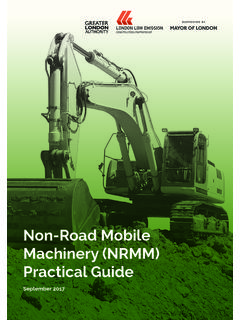Transcription of A Practical Guide to Shaft Alignment - Plant Services
1 1 Edition 4; Copyright 2002 PRUFTECHNIK LTD All rights reservedDistributed in the by LUDECA Inc. A Practical Guide toShaft AlignmentCare has been taken by the authors, PRUFTECHNIK LTD, in the preparation of this publication. It is not intended as a comprehensive Guide to Alignment of process machinery, nor is it a sub-stitute for seeking professional advice or reference to the manufacturers of the machinery. No liability whatsoever can be accepted by PRUFTECHNIK LTD, PRUFTECHNIK AG or its subsidia-ries for actions taken based on information contained in this publication. PRUFTECHNIK AG and/or its subsidiaries assume no responsibility directly or indirectly for any claims from third parties resulting from use or application of information contained in this handbook.
2 2002 PRUFTECHNIK purpose of producing this handbook is to provide basic information and guidelines for the implementation of good Shaft Alignment for standard rotating machine systems. Laser Alignment is an essential component of a viable maintenance strategy for rotating machines. In isolation each strategy can help to reduce unexpected machine failure but taken together they form the hub of a proactive maintenance strategy that will not only identify incipient problems but allows extending machine operating life considerably. In each section of this handbook we have used one or two examples of the available methods for measuring the required parameters. We do not suggest that the methods illustrated are the only ones available. Prueftechnik are specialists in the Alignment and monitoring of rotating machines, we have accumulated substantial Practical knowledge of these subjects over the 30 years of our existence, in so doing we have produced many handbooks covering individual subjects and systems.
3 This handbook is a distillation of this accumulated knowledge plus a brief overview in each section of the latest systems from Prueftechnik that address the specific applications hope that this information is presented in a clear readable form and that it will provide for the reader new to the subject a platform to successfully apply profitable maintenance practice in their are indebted to our collegues in Prueftechnik AG (Germany) and our associates at LUDECA Inc. (USA) for permission to reproduce some of the graphics used in this handbook, additionally we have drawn on information previously published in Prueftechnik equipment handbooks for information on Alignment standards, and graphical and mathematical methods of balance calculation. For this information we are grateful.
4 Introduction 2002 PRUFTECHNIK Alignment Page NumberWhat is Shaft Alignment 6 .. A definition 6 .. Machine catenary 7 .. Operation above critical speed 8 Expressing Alignment 10 .. Alignment parameters 10 .. Angularity, gap and offset 11 .. Short flexible couplings 14 .. Spacer shafts 15 How precise should Alignment be? 18 .. Alignment tolerances 18 Troubleshooting 21 .. Coupling strain and Shaft deflection 21 Causes of machine breakdown 23 .. Couplings and misalignment 23 .. Bearings 24 .. Seal wear 24 .. Machine vibration 25 .. Symptons of misalignment 25 Alignment methods and practice 27 .. Machine installation guidelines 28.
5 Measurement and correction of soft foot 29 Alignment by Eyesight 33 Introduction 2002 PRUFTECHNIK Alignment by Dial indicator 36 .. Trial and error method 37 .. Rim and face method - by calculation 38 .. Reverse indicator method - by calculation 41 .. Indicator bracket sag measurement 43 Alignment by Laser 45 .. Basic operation requirements 48 Laser Alignment case study .. Laser Alignment cuts energy costs 52 .. Laser Alignment improves pump reliability 56 .. Laser Alignment improves bearing & seal life 58 .. Laser Alignment reduces vibration alarms 59 Thermal expansion of machines 60 .. Thermal growth calculations 61 Page Number Contents 2002 PRUFTECHNIK 2002 PRUFTECHNIK is Shaft Alignment ?
6 Drive Shaft operation above critical speed:Align machine couplings to one another ignoring spacer. 2002 PRUFTECHNIK precise should Alignment be? Alignment tolerances for flexible couplingsThe suggested tolerances shown on the following pages are general values based upon over 20 years of Shaft Alignment experience at Prueftechnik and should not be exceeded. They should be used only if no other tolerances are prescribed by existing in-house standards or by the machine all values to be the maximum allowable deviation from the Alignment target, be it zero or some desired value to compensate for thermal growth. In most cases a quick glance at the table will tell whether coupling misalignment is allowable or an example, a machine with a short flexible coupling running at 1800 RPM has coupling offsets of mils vertically and mil horizontally, both of these values fall within the excellent limit of is usually measured in terms of gap difference.
7 For a given amount of angularity, the larger the diameter the wider the gap at the coupling rim (see page 12). The following table lists values for coupling diameters of 10 inches. For other coupling diameters multiply the value from the table by the appropriate factor. For example, a machine running at 1800 RPM has a coupling diameter of 3 inches. At this diameter the maximum allowable gap would be: spacer shafts the table gives the maximum allowable offset for 1 inch of spacer Shaft length. For example, a machine running at 1800 RPM with 12 inch of spacer Shaft length would allow a maximum offset of: mils/inch x 12 inches = mils at either coupling at the ends of the spacer couplings have no tolerance for misalignment, they should be aligned as accurately as possible.
8 2002 PRUFTECHNIK precise should Alignment be?Suggested Alignment tolerance table 2002 PRUFTECHNIK precise should Alignment be?NoteFor industrial equipment the amount of misalignment that can be tolerated is a function of many variables including RPM, power rating, coupling type, spacer length, design of coupled equipment and expectations of the user with respect to service life. Since it is not Practical to consider all these variables in a reasonably useful Alignment specification, some simplification of tolerances is based on RPM and coupling spacer length were first published in the 1970 s. Many of the tolerances were based primarily on experience with lubricated gear type couplings. Experience has shown however that these tolerances are equally applicable to the vast majority of non lubricated coupling systems that employ flexible elements in their the previous table acceptable limits are calculated from the sliding velocity of lubricated steel on steel, using a value of inch/sec for allowable sliding velocity.
9 Since these values also coincide with those derived from elastomer shear rates they can be applied to short flexible couplings with flexible elements. Excellent values are based on observation made on a wide variety of machines to determine critical misalignment for vibration. Compliance with these tolerances does not however guarantee vibration free operation. 2002 PRUFTECHNIK of machine breakdownCouplings can take misalignment?An often quoted comment is ..why bother to align the machine when it is fitted with a flexible coupling designed to take misalignment? Experience and coupling manufacturers maximum misalignment recommendations would suggest otherwise. Anecdotal evidence suggests that as much as 50% of machine breakdowns can be directly attributed to incorrect Shaft is true that flexible couplings are designed to take misalignment, typically up to 400 mils or more radial offset of the shafts.
10 But the load imposed on shafts, and thus the bearings and seals increase dramatically due to the reaction forces created within the coupling when misaligned. 2002 PRUFTECHNIK of machine breakdownAnti-friction BearingsBearings are precision manufactured components designed to operate with clean lubrication and constant but restricted operating temperatures. Components manufactured within mils accuracy are: Not able to withstand operating for long periods at elevated temperatures caused by misalignment. Not able to withstand contamination caused by mechanical seal failure which has allowed ingress of dirt, grit, metallic elements or other objects. Not manufactured to operate for long periods with misalignment imposing axial shock loads on the carefully machined and honed addition to the damage imposed on the bearings through the misalignment itself, when mechanical seals fail, bearings have to be removed from the Shaft assembly, sometimes re-fitted or in most cases replaced.
